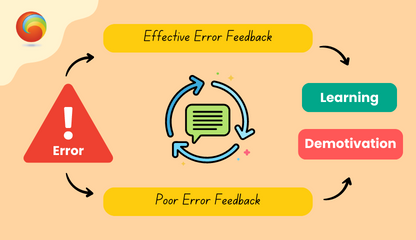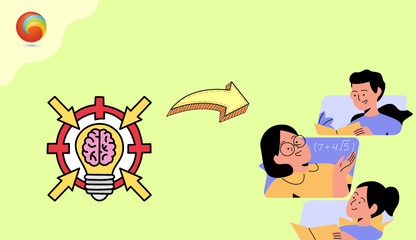Active Engagement: The Second Pillar Of Learning
Active engagement—the second pillar of learning—is an algorithm also called “curiosity,” which encourages our brain to ceaselessly test new hypotheses, which is also a second pillar of learning.
To learn, our brain must first form a hypothetical mental model of the outside world, which it then projects onto its environment and puts to the test by comparing its predictions to what it receives from the senses. Efficient learning means refusing passivity, engaging, exploring, and actively generating hypotheses and testing them in the outside world. Motivation is essential: we learn well only if we have a clear goal and fully commit to reaching it.
Active engagement — the second pillar of learning — takes place in our brains, not our feet. The brain learns efficiently only if it is attentive, focused, and active in generating mental models. To better digest new concepts, active students constantly rephrase them into words or thoughts of their own. Without attention, effort, and in-depth reflection, the lesson fades away without leaving much of a trace in the brain.
One of the foundations of active engagement is curiosity — the desire to learn or the thirst for knowledge. It is a key ingredient of our learning algorithm. Curiosity is a fundamental drive of the organism: a propulsive force that pushes us to act, just like hunger, thirst, the need for security, or the desire to reproduce.

Curiosity occurs whenever our brains detect a gap between what we already know and what we would like to know — a potential learning area. Curiosity would be the brain’s governor, a regulator that seeks to maintain a certain learning pressure. Curiosity, the algorithm of active engagement, guides us to what we think we can learn. Its opposite, boredom, turns us away from what we already know or from areas that, according to our past experience, are unlikely to have anything left to teach us.
The degree of curiosity that you report correlates tightly with the activity of the nucleus accumbens and the ventral tegmental area, two essential regions of the dopamine brain circuit. The more curious you are, the more these regions light up. Their signals arise in anticipation of the answer; even before your curiosity is satisfied, the simple fact of knowing that you will soon know the answer excites your dopaminergic circuits.
The expectation of a positive event brings its own reward. These curiosity signals are obviously useful because they predict how much you learn. Memory and curiosity are linked — the more curious you are about something, the more likely you are to remember it. Curiosity even transfers to nearby events; when your curiosity is heightened, you remember incidental details. The degree of craving for knowledge controls the strength of memory.
Active engagement, the second pillar of learning, leads to an interesting prediction. It implies that in order for people to be curious, they must be aware of what they do not yet know. In other words, they must possess metacognitive faculties at an early age. “Metacognition” is cognition over cognition: the set of higher-order cognitive systems that monitor our mental processes.
According to the gap theory of curiosity, metacognitive systems must constantly supervise our learning, evaluating what we know and don’t know, whether we are wrong or not, whether we are fast or slow, and so on and so forth — metacognition encompasses everything we know about our own minds. Metacognition plays a key role in curiosity. Indeed, to be curious is to want to know, and that implies knowing what you don’t already know.
PASSIVE VS. ACTIVE LEARNING

A large body of research has shown big differences in outcomes between passive and active learning. In one carefully executed experiment, physics instructors taught their course in two ways: some classes were taught in a conventional style, and others used active learning. Even though the teachers were the same and the students were similar, on average, the active learners doubled their understanding when they were tested at the end of the course.
Remember that two modes of learning coexist in the human species: the active mode, known as active engagement — the second pillar of learning, where children constantly experiment and question themselves like good budding scientists, and the receptive mode, where they simply record what others teach them. School often encourages only the second mode, and it may even discourage the first if children assume that teachers always know everything better than students do.
The ideal scenario is to offer the guidance of a structured pedagogy while encouraging children’s creativity by letting them know that there are still a thousand things to discover.
Our brains thrive when they actively generate hypotheses, test them against the outside world, and remain attentive and focused. Active engagement, the second pillar of learning, serves as a driving force, pushing us to explore areas where there is a gap between what we already know and what we desire to know. Furthermore, metacognition, the ability to monitor and evaluate our own mental processes, is crucial for fostering curiosity and the desire to acquire new knowledge.
Frequently Asked Questions
-
What are the 4 pillars of training?
- Knowledge: Acquiring the necessary information and understanding of the subject matter.
- Skills: Developing practical abilities and expertise through practice and hands-on experience.
- Attitude: Cultivating a positive mindset, motivation, and a willingness to learn and improve.
- Behavior: Incorporating learned knowledge and skills into one’s actions and daily practices.
-
What are the 4 pillars of education in India?
- The four pillars of education in India are:
- Learning to know: Acquiring knowledge, critical thinking skills, and a broad understanding of various subjects.
- Learning to do: Developing practical skills, vocational training, and the ability to apply knowledge in real-life situations.
- Learning to be: Fostering holistic development, personal growth, and nurturing values, ethics, and character.
- Learning to live together: Promoting social awareness, empathy, inclusivity, and the ability to interact harmoniously in a diverse society.
-
Who gave the four pillars of learning?
- The four pillars of learning were proposed by UNESCO (United Nations Educational, Scientific and Cultural Organization) in the Delors Report titled “Learning: The Treasure Within” in 1996.
-
What are the 4 pillars of cognition?
- There is no widely recognized or established framework that specifically identifies the “four pillars of cognition.” Different models and theories may propose different components or pillars within the field of cognition, but there is no universally agreed-upon set of pillars.



